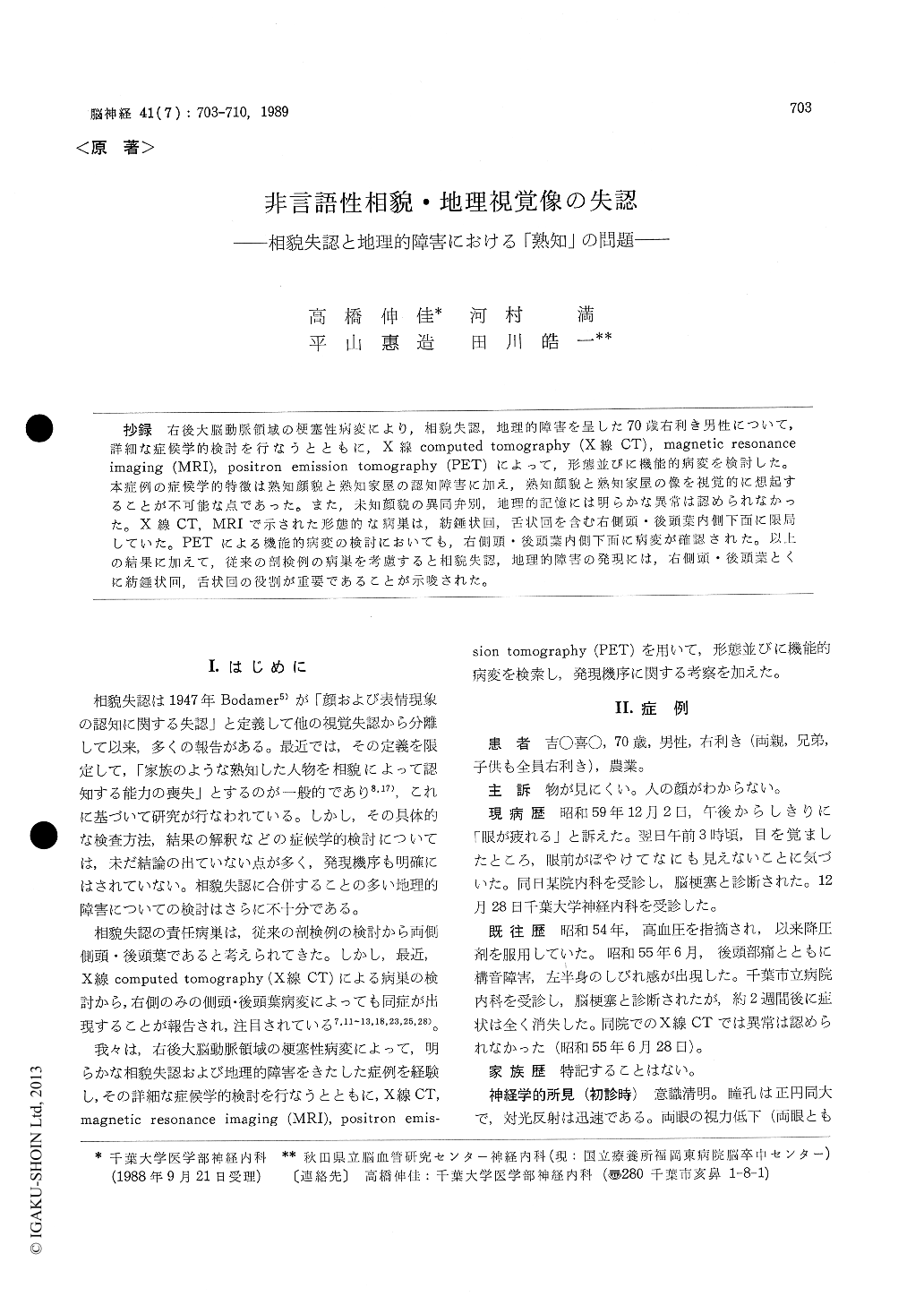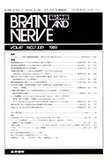Japanese
English
- 有料閲覧
- Abstract 文献概要
- 1ページ目 Look Inside
抄録 右後大脳動脈領域の梗塞性病変により,相貌失認,地理的障害を呈した70歳右利き男性について,詳細な症候学的検討を行なうとともに,X線computed tomography (X線CT), magnetic resonanceimaging (MRI), positron emission tomography (PET)によって,形態並びに機能的病変を検討した。本症例の症候学的特徴は熟知顔貌と熟知家屋の認知障害に加え,熟知顔貌と熟知家屋の像を視覚的に想起することが不可能な点であった。また,未知顔貌の異同弁別,地理的記憶には明らかな異常は認められなかった。X線CT,MRIで示された形態的な病巣は,紡錘状回,舌状回を含む右側頭・後頭葉内側下面に限局していた。PETによる機能的病変の検討においても,右側頭・後頭葉内側下面に病変が確認された。以上の結果に加えて,従来の剖検例の病巣を考慮すると相貌失認,地理的障害の発現には,右側頭・後頭葉とくに紡錘状回,舌状回の役割が重要であることが示唆された。
In recent years, prosopagnosia is defined as the "loss of ability to recognize the well-acquainted persons like the family members by their physio-gnomy." There are many reports based on this definition. However, from the viewpoint of symp-tomatology, there are many problems not entirely solved yet. And the mechanism of its manifesta-tion is not clearly explained. Topographic disori-entation, which often accompanies prosopagnosia, is studied even less. From the results of the post-mortem examination in the literature, bilateral occipito-temporal lesions have been known to cause prosopagnosia. However, the recent radio-graphical examination by the computed tomography revealed that the prosopagnosia is also caused bythe right occipito-temporal lesions only.
We experienced a case with prosopagnosia and topographic disoriention which were considered to be caused by infarction in the territory of the right posterior cerebral artery.
Detailed symptomatological, morphological and functional examinations were carried out by means of various psychological testing, X-ray computed tomography (CT), magnetic resonance imaging (MRI) and positron emission tomography (PET).
The patient was a 70-year-old right-handed man who suffered from sudden visual loss on both eyes, and was admitted to our hospital after four weeks. On examination, a decrease of visual acuity and right homonymous hemianopsia were recognized. When visual acuity was recovered, he was unable to recognize the faces of his relatives and friends, with whom he has been well acquainted for many years. He also found his own house, the buildings and streets around it as entirely unfamiliar.
Seven months after the onset of the disease, ex-amination showed he had definite prosopagnosia and topographic disorientation. He also neglected the left half of space and the disturbance of con-structive behavior was noticed. WAIS showed verbal IQ 115, performance IQ 62 and general IQ 96. By the detailed symptomatological study, we summarized the features of this case in the follow-ing four points : ( 1 ) The patient suffered from prosopagnosia, unable to identify the physiogno-my of the persons whom he should be able to re-cognize. The patient was also unable to remember the physiognomical image of his family members,but he could describe the features of the physio-gnomical components of their faces (such as eyes, nose, mouth, etc.). ( 2 ) He was able to identify the unfamiliar faces. ( 3 ) The patient could recognize and identify facial expressions, age, sex and beauty or ugliness. ( 4 ) As for the topographic disori-entation accompanying prosopagnosia, he was un-able to identify the buildings and street scenes in the photographies, which he should be familiar with, but the so-called disorder of topographical memory was not noticed.
Radiographic examination by the computed to-mography revealed the lesion on the lower inside of right temporal and occipital lobe as a low den-sity area. By MRI, the lesion was also limited to the same area, more specifically in the fusiform and lingual gyri. The functional examination by PET showed no definite lesion in the left cerebral hemi-sphere.
Based on the results of these examinations to-gethere with the data in the literature, we reached the following conclusions : ( a ) The agnosias of the familiar faces and the unfamiliar faces are considered to be caused by the different mecha-nisms. ( b ) It is suggested that the prosopagnosia is caused by the disturbance of the physiognomical memory or by the disconnection between morpho-logical recognition for physiognomy and its memo-ry, rather than the disturbance of recognition itself. ( c ) The right fusiform and lingual gyri are considered to be most important in prosopa-gnosia.

Copyright © 1989, Igaku-Shoin Ltd. All rights reserved.


